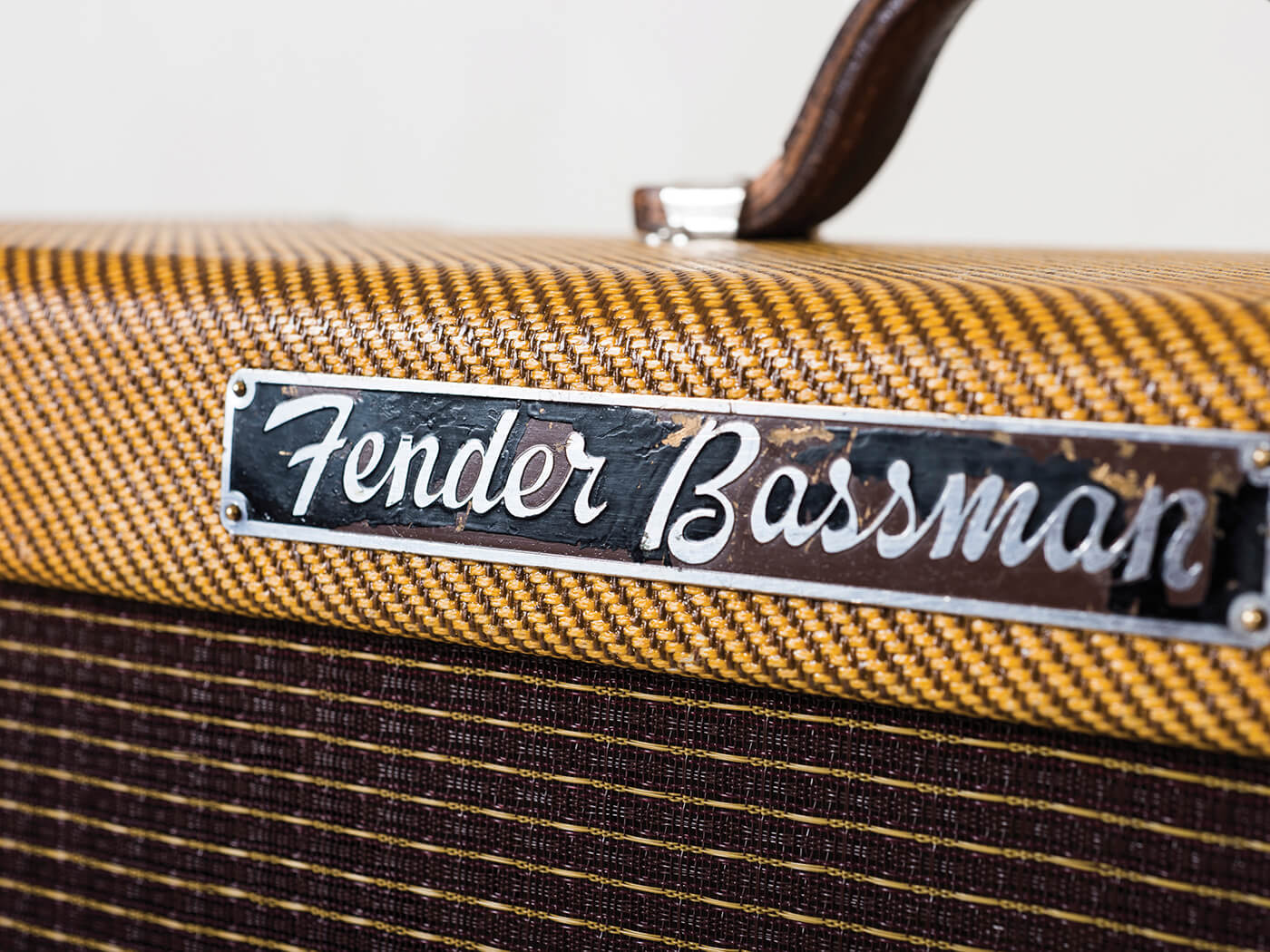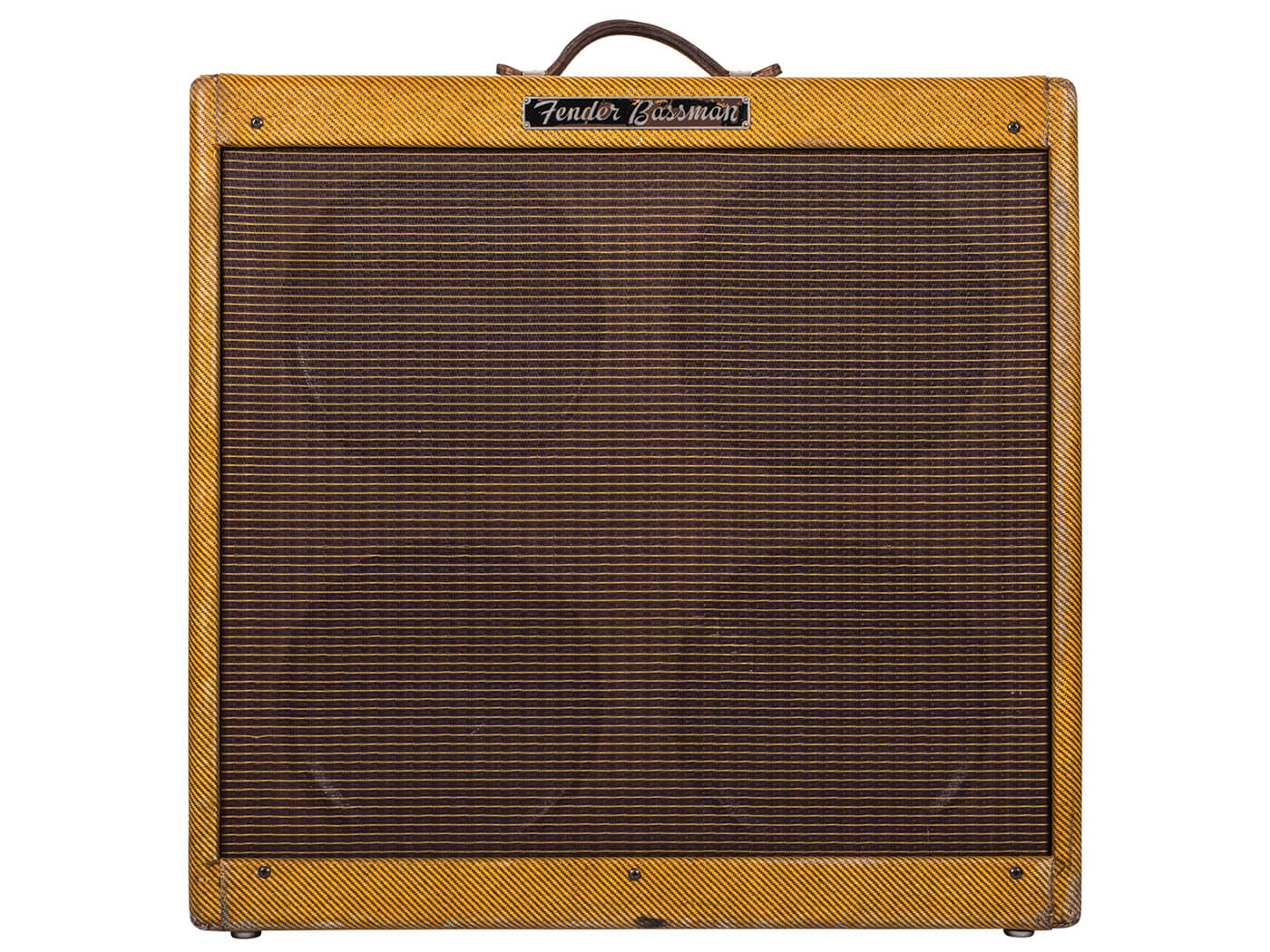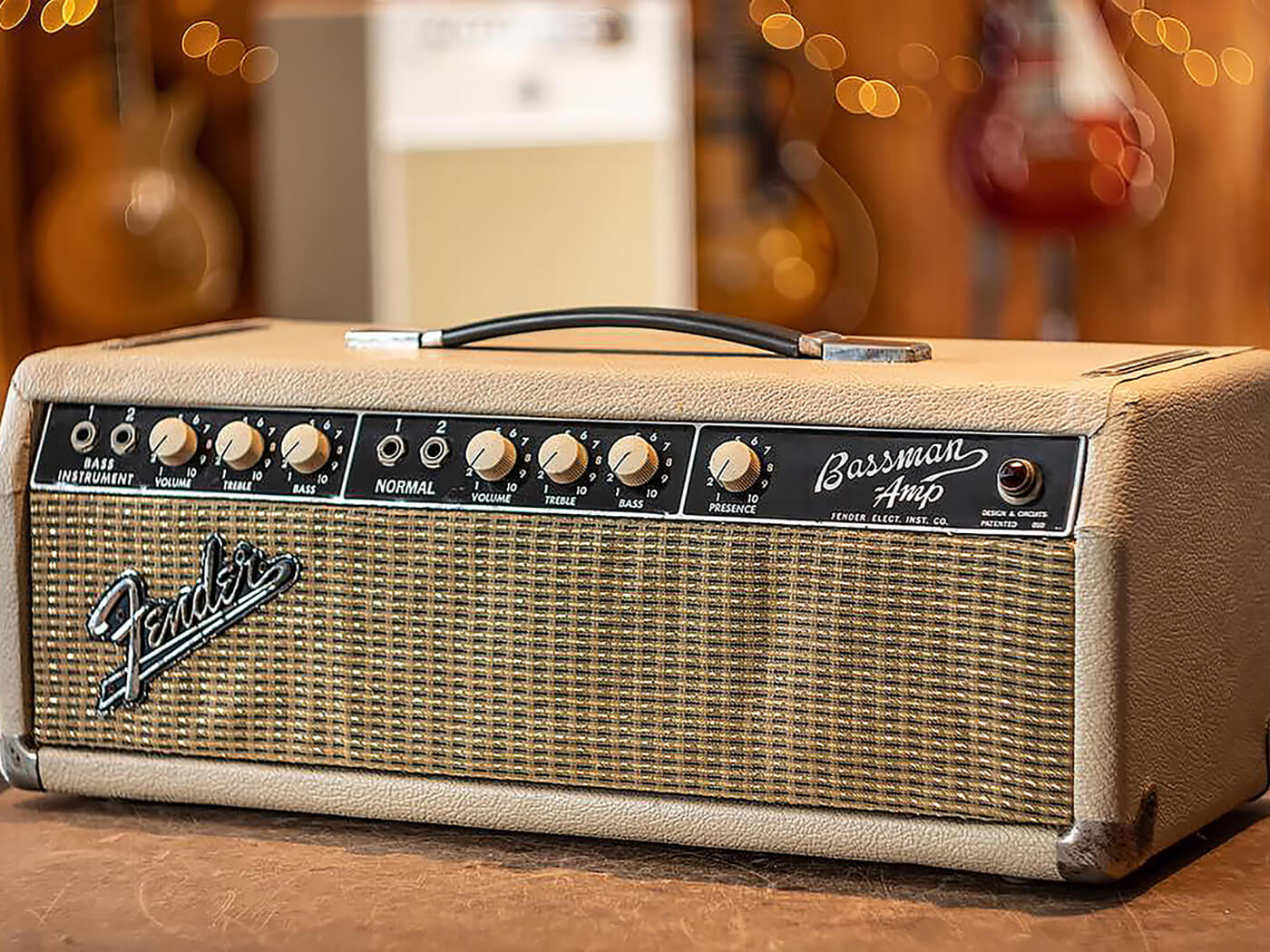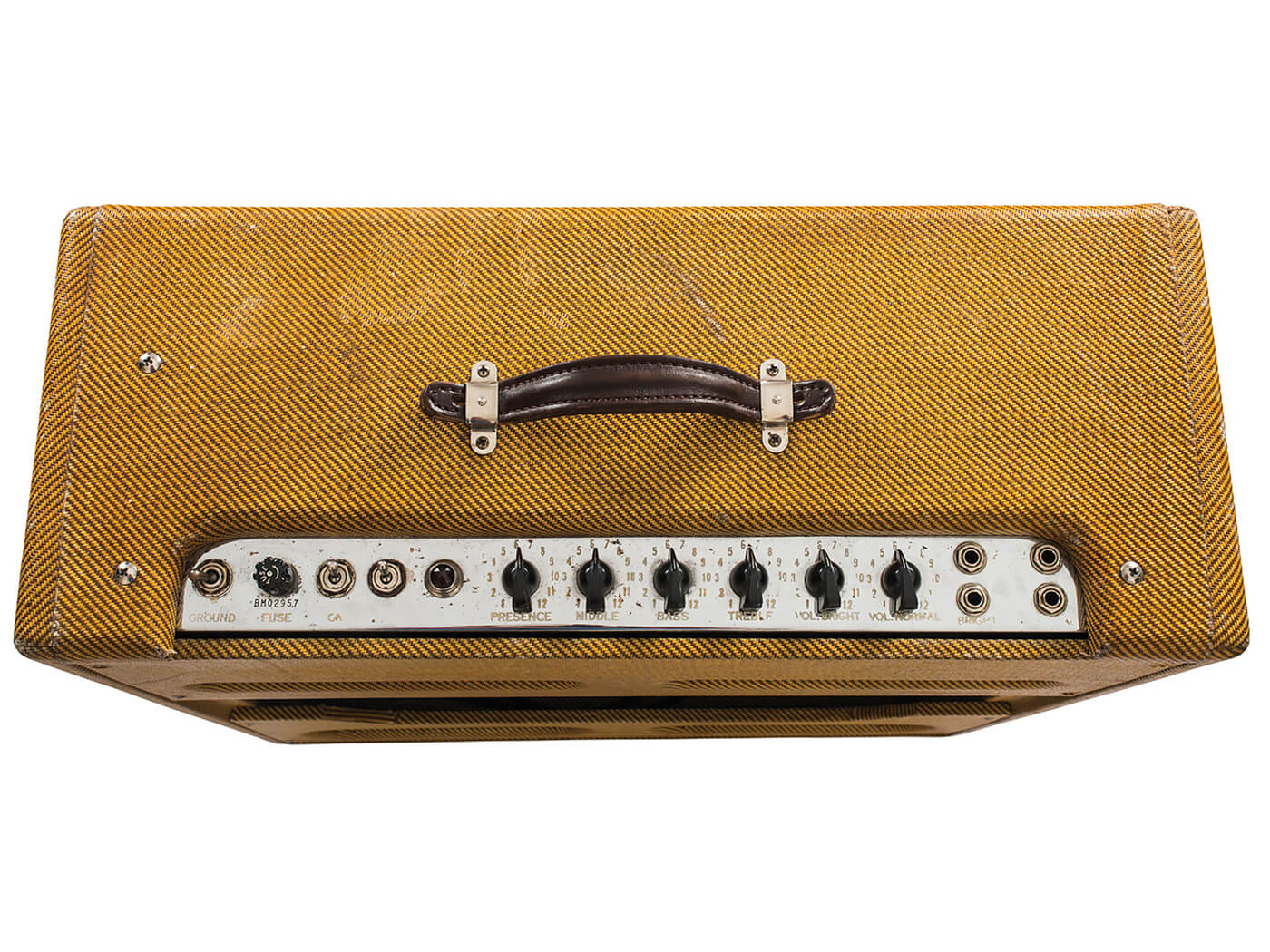Why the Fender Bassman is the greatest amp of all
Guitar effects would be pretty pointless if we never had amps to use them with, and Josh Scott wants to talk about one very important amp in particular.

Previously, I told you that my favourite amp is my all-original 1959 Fender Bassman; now I’m going to try to explain to you why. Simply put, it’s the definition of perfect. Without ever turning it on, it demands a certain attention by way of its yellow tweed covering, aged and abused from over 60 years of use. When it is on, its 45 watts of power gives you massive clean tones that can stand up next to any drummer, beautiful tube saturation when pushed to high volumes, and the ability to accept overdrive and fuzz pedals as if they are part of its very DNA. Instead of one speaker like most amps of its era, it has four blue-label 10-inch speakers that are as loud as they look, positioned perfectly into the 23-inch cabinet, ensuring that when you need it to, it can fill a room without a microphone in sight.
Plug in any guitar that you want – go ahead, I’ll wait – and it will be impossible to find a bad sound using its six simple controls. Notes will fall effortlessly out of your hands and into your ears; perfect bass response and the most balanced high end of any amp I’ve ever played.
From a design perspective, the Fender Bassman is legendary – and for good reason. This is the major evolutionary step forward that took us from the lunchbox-sized, 1930s Rickenbacker amplifiers that just barely amplified beyond natural projection to the refrigerator-sized stacks of amps that Hendrix and others used in the mid-60s. It is everything an amp should be, but it’s also more than that: it is a living, breathing organism that lives to tell a story.
This amplifier, like none other, sits at a pivotal place in history, when the infancy of 1950s jingle-jangly rock ‘n’ roll was about to collide with the purpose and angst of the 1960s rock invasion. There is a reason that this particular amp is one of the most sought after of all time, and, in my opinion, it goes beyond tone. This amp is a physical representation of the sonic transformation happening at the dawn of guitar’s greatest age. You could even call it the Cambrian explosion of the electrified guitar – yeah, I’m throwing out some heavy-duty scientific terms at you today, just roll with it – but like all other great inventions, it started with a man and an idea.

The radio repair man
It’s an oft-repeated fact that Leo Fender was a mechanic and radio repair technician, not a musician, but he was no average repairman – the spark of electronic creativity had gripped Leo at a young age, and he was forever tinkering and inventing in search of his next great idea. Indeed, so dedicated was he to electronic innovation, that Leo dated the establishment of his radio repair business all the way back to 1922, when he became obsessed with radio electronics at age 13.
By 1946, he was still a nerd who wore overalls almost every day and just loved to build stuff. Even though he couldn’t play an instrument, he enjoyed live music. He lived in the Los Angeles area, and fell in love with the Texas swing bands that toured through Orange County and played the local club scene.
Even better, Leo’s presence in and around this scene meant that he witnessed jazz, blues and country merge into a new genre called rock ‘n’ roll. He was the right person in the right place at the right time, positioned to make his mark on music history.
Before he got into guitars, Leo serviced theatre amplification systems for local clubs and venues and had developed a deep understanding of how they worked, and how they could be used to make live music even louder. These theatre system designs inspired Leo to create his first guitar amplifiers by 1946, which he released in three options: the Princeton, Deluxe (also called the ‘Model 26’) and Professional. To be clear, he didn’t invent the guitar amplifier, they had been available years before, but he evolved the concept in the same way that Henry Ford had evolved transportation – things would never be the same again. If the amps of the 1930s were covered wagons, Leo’s amps were the Model T. Leo gave the guitar an engine; he made the guitar loud.
Electric avenue
And in many ways, it had to be that way. In a recent interview with guitar historian George Gruhn, he told me, “You’re not going to have an amplifier invented by somebody who’s a guitar maker. It’s going to be invented by somebody who’s an electronic technician. And the electronic technicians were working first for radio, which came before talking movies. Radio was electronics.”
For the guitar to evolve, hundreds of small, seemingly unimportant inventions (many created by men and women who had never picked up a guitar in their lives) had to add up. It was a process that took decades, but to the public it seemed to happen overnight. Even though Leo Fender and the innovators that would follow him got this advancement off the ground, radio technology gave them the tools to do it.
The guitar amps produced in the 1930s by companies like Rickenbacker were metal-covered devices the size of a bread box with a tiny speaker. You could increase the volume so that the guitar was louder than it had ever been before – but the bar for volume was so freakin’ low in the 1930s and 40s that this isn’t saying much. The amp still couldn’t amplify the sound to anything near the volume of 50s and 60s rock. The guitar had been electrified, but it wasn’t rock ‘n’ roll. Not until Leo Fender came along.
By the time 1949 came around, when Fender introduced the first versions of the solidbody Telecaster (the most important electric guitar ever created) to the world, Leo was already making loud, usable, rockin’ amplifiers to plug them in to. Unlike the other brands on the market, when you played this new revolutionary Fender guitar, you had an equally powerful amplifier to plug it into. This combination gave Fender the upper hand in forging a new way towards rock ‘n’ roll. Everyone afterwards was simply following in the footsteps of a radio technician from California. I hear what you’re thinking: the solidbody electric guitar amplifier came before the solidbody electric guitar? Yup!

Cart before horse?
In many ways the reason for this is actually pretty understandable – Leo recognised the demand for more volume, and everything flowed from that. He created an amp that could actually produce the raw power that his musician friends wanted, and when it became obvious that a standard acoustic guitar – even amplified – wasn’t getting the job done, he began developing solidbody guitars that could keep up.
What’s important here is to understand that Leo didn’t look into the world of guitar to fix the problems of the guitar; instead, he looked to other arenas where technology had already solved these same problems. Leo used the advancement of radio and theatre sound systems to evolve the amplification of the guitar; he borrowed proven technology to create something that had never been seen.
Around the same time that the Telecaster became the guitar of choice for the modern musician, Leo also introduced a fretted electric bass called the Precision. Now, in time players like Carol Kaye would use this guitar to revolutionize the bassline of popular music and directly influenced the way that song structure would evolve in the coming decades, but again Leo wasn’t the first on the scene here. Audiovox had already produced a fretted electric bass and solidbody guitars by this time, but again Leo understood that people wanted loud.
Guitars and basses had previously struggled to be heard above the powerful projection of brass and woodwind instruments, but plug a Fender electric instrument into a Fender electric amp, and one guy could play louder than a symphony orchestra. But this had some real-world consequences that Leo could never have anticipated – remember our friends at the American Federation of Musicians getting upset that the talkies were putting thousands of movie theatre musicians out of work? They were about to get some company.
Imagine you’re a club owner and you do live dance music on the weekends. You’ve been bringing in these Big Bands, but they are bananas expensive. You have to pay a whole busload of musicians (maybe 30 people altogether) and a conductor and a director and an entourage handling all the arrangements. And then all of a sudden, you’re given the alternative of paying three snot-nosed kids in their twenties whose newfangled electric instruments could out-shout those orchestras with ease? It was Charles Darwin’s natural selection all over again, but with dollars instead of dinosaurs – invention would continue its evolution, at least it would once they got past one small issue.
Great leap forward
When Leo Fender’s revolutionary Precision bass arrived in 1951, there was one slight snag holding back evolution. The bass amp as we know it didn’t exist yet. Leo’s original trio of amps might have appeared in 1946, but the Bassman wouldn’t arrive until 1952. And I know what you’re thinking here – ‘Hang on Josh, are you trying to tell me that after everything you said about Leo’s understanding of the need for loud, the P-Bass existed for a whole year before they had anything to properly amplify it with? How the heck does that work?!’
Y’all, what can I tell you – we live in an imperfect universe and even generational geniuses are allowed a Mulligan or two along the way. Anyway, in a bizarre reverse chicken/egg situation to the solidbody electric guitar, the bass came first, and necessity being the mother of invention, it barely took them a year to realise that these newly converted electric four-stringers might need something a bit more potent to work with than the existing amp offerings – enter Bassman.

Like most of Leo’s other creations in that wildly inventive decade, the Bassman quickly saw several internal and cosmetic changes until reaching its perfect state with the 1959 model. But somehow, nobody noticed, and Fender soon fully abandoned the 4×10 combo format and switched to a separate head and speaker cabinet arrangement. But by that point, the Bassman’s history had already taken another left turn.
Back in black
Over on the other side of the Atlantic, the Bassman was going to propel the guitar amp evolution in a way that the Western Swing-loving Leo had never even imagined. Fender might have abandoned the 4×10 Bassman in 1960, but Jim Marshall couldn’t get enough of them. The Englishman had been importing Fender amps into the UK and selling them out of his shop in West London, and they sold like hotcakes – or whatever the British equivalent is… crumpets? [Let’s not get into this – Ed] – to the young guitar players in London’s rapidly growing music scene.
This was of course a very different time, this is pre-internet, pre-modern distribution, pre-eBay, and pre…anything. What’s more, the post-war trade bans made getting hold of American-made US instruments in the UK extremely tricky in the 50s and even as these restrictions relaxed in the 60s, sourcing gear from America was a difficult and expensive job.
Eventually the high cost of import taxes, sea freight and simple availability of these highly desired American amplifiers made Marshall think there had to be a better way – if he could get someone to build him an amp based on these Fender designs in the UK, he’d save himself a lot of hassle, and improve his profit margin considerably.
Now, Jim was a savvy businessman, but he was no electronics whiz, and so he turned to engineer Dudley Craven to build him an amplifier, and in the 1959 Fender Bassman, they had the perfect blueprint to start from. And so Craven and fellow electronic technician Ken Bran retreated to Craven’s garden shed/ham radio base and transformed the Fender Bassman circuit into the Marshall JTM45. Webster defines evolution as “a process of change in a certain direction” and this moment in September 1963 was just that; Leo Fender’s Southern California amplifier evolved onward in London, destined to fuel the music of Eric Clapton, Jimi Hendrix, Angus Young, Eddie Van Halen and countless other guitar gods.

What’s next?
It has been 62 years since my 1959 Bassman rolled off the production line in Fullerton, CA. I would love to travel back in time and watch what that was like: the sounds of the factory, the conversations of the day, maybe even see Leo roaming around the shop floor solving a problem. I can imagine my amp shipping out the door into an unknown world ahead of its time. What store sold it first? Who was the original owner? Were they famous? Have I heard my amp on a song before and just don’t know it? If my amp could talk, it would have six decades of stories to tell. What songs did it get to amplify? What moment was it part of? We may never know, but it’s fun to imagine. I believe it’s a gift to look into the past because it might help us predict what’s in the future.
Truth be told, electric guitar hasn’t changed all that much since Leo’s inventions. Sure, we have digital effects, modelling amps, $500,000 Klons as well as some different shaped guitars, but at the heart of it all is still a magnet, strings and an amplifier that can project what we play.
When the first electric guitar was invented by Rickenbacker, they never saw Fender coming. When Fender made his first amps, he never saw Marshall coming and no one at Ford Motor Company ever dreamed of the Tesla electric car. Invention is rarely predictable, and it is most definitely not simple.
Do me a favour. Just take a moment here. Close your eyes and try to imagine what’s coming next. Is it in front of us now? Is it still evolving behind closed doors? What will the Tesla of guitar look like? Who is going to be the next great innovator of guitar? If history is a teacher, it would tell us that the chances are good that you’ve never even heard their name.
Hopefully that inventor is reading this right now. If you are, just remember that I believed in you first. I may want to interview you on The JHS Show in about 30 years.
Join Josh for more effects adventures at thejhsshow.com.




